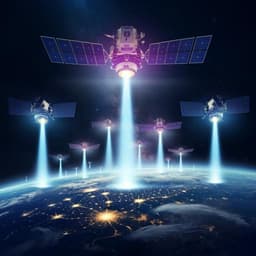
Physics
Beyond the standard quantum limit for parametric amplification of broadband signals
M. Renger, S. Pogorzalek, et al.
A groundbreaking study by M. Renger, S. Pogorzalek, Q. Chen, Y. Nojiri, K. Inomata, Y. Nakamura, M. Partanen, A. Marx, R. Gross, F. Deppe, and K. G. Fedorov reveals that the standard quantum limit for low-noise amplification of weak microwave signals can be surpassed, potentially revolutionizing quantum information processing!
~3 min • Beginner • English
Introduction
The study addresses how to surpass the standard quantum limit (SQL) for phase-preserving linear amplification of weak microwave signals, a central task in quantum information processing and state readout. Conventional amplifiers must add at least half a photon of noise in the high-gain limit, limiting quantum efficiency to 0.5. The authors propose and analyze nondegenerate parametric amplification in a broadband-input regime, where the idler mode is within the input signal bandwidth and can carry signal information rather than act as a noise port. They aim to derive the quantum limits for such multimode inputs and to experimentally demonstrate quantum efficiency beyond the SQL using a flux-driven Josephson parametric amplifier (JPA). This has implications for high-fidelity quantum measurements and the detection of ultraweak microwave signals.
Literature Review
Prior work established quantum limits for phase-preserving linear amplifiers (Caves; Caves et al.) and demonstrated quantum-limited microwave amplification with Josephson parametric amplifiers (JPAs) and traveling-wave parametric amplifiers (JTWPAs). JTWPAs achieved noise performance at 2.1× SQL. Phase-sensitive degenerate JPAs can be noiseless for a specific quadrature, but conventional nondegenerate phase-preserving amplification of narrowband signals is limited by the SQL due to the idler adding at least vacuum noise. Nonreciprocal amplifiers and two-mode squeezing have also been explored. Applications requiring ultra-low-noise amplification include qubit readout, entanglement generation, quantum illumination, axion detection, and CMB measurements. The present work complements these by focusing on nondegenerate amplification when the input signal is broadband so that signal and idler bands are both populated, potentially avoiding the SQL.
Methodology
Theory: The authors define quantum efficiency η = 1/(1 + 2 n_f), where n_f is the number of noise photons referred to the input. For narrowband nondegenerate amplification, the idler contributes n_f = n_i (1 − G_n^{-1}), yielding η ≤ (2 G_n − 1)^{-1} → 0.5 at high gain. They then treat a multimode input signal with bandwidth b_s around ω_s, while the JPA provides nondegenerate three-wave mixing (pump at ω_p = 2 ω_0, signal at ω_s = ω_0 + Δ, idler at ω_i = ω_0 − Δ). Using a linear input-output relation ĉ(ω) = ∫ dω' [M(ω) δ(ω−ω') â(ω') + L(ω) δ(ω−ω') â†(ω')] + f(ω), with |M|^2 = G(ω), |L|^2 = G(ω)−1, and an additive noise mode f(ω) with spectral density S_f(ω), they calculate commutators and spectral autocorrelations to derive a bound on the integrated added noise. They identify two bandwidth thresholds b_1 = 2Δ − B and b_2 = 2Δ + B (B is measurement bandwidth). For b_s ≤ b_1 the SQL is recovered; for b_1 ≤ b_s ≤ b_2 the lower bound decreases as signal overlaps idler modes; for b_s ≥ b_2, the lower bound goes to η ≥ 0, meaning no fundamental added-noise limit from SQL in this broadband case. For a Lorentzian JPA gain G_n(ω) = 1 + G_0 β / (β^2 + (ω − ω_0)^2) with gain-bandwidth product τ = b_j G_0, assuming G_0 ≫ 1, they solve for the bandwidth dependence of the quantum limit η_ql as a function of b_s, Δ, and B (Eq. 8), and show that in the broadband regime η_ql → 1 in terms of achievable quantum efficiency.
Experiment: A flux-driven JPA is operated in the nondegenerate regime by detuning the signal frequency by Δ/2π = 300 kHz from ω_p/2 = ω_0. The measurement bandwidth is B/2π = 200 kHz around ω_s. Two JPAs (JPA 1 at ω_s/2π = 5.500 GHz; JPA 2 at 5.435 GHz) are evaluated for reproducibility. The JPA output is routed to a cryogenic HEMT amplifier (gain G_H = 41 dB). Broadband thermal input states are generated using a heatable 30 dB attenuator (40–600 mK), and coherent tones are used for narrowband characterization. Output quadratures are digitized, filtered, and analyzed via reference-state reconstruction. Broadband and narrowband gains are related by G_b = 2 G_n − 1 when signal and idler inputs are uncorrelated. Planck spectroscopy is used to determine the total added noise photons referred to input by fitting detected power versus attenuator temperature to Planck curves; offsets yield noise photon numbers. For narrowband coherent inputs, the input photon number is calibrated with the JPA off, then with the JPA on the output photon number versus input is linearly fit to extract gain and added noise. The dependence of quantum efficiency on gain is modeled using Friis’ equation with HEMT noise n_H and a gain-dependent JPA noise term attributed to pump-induced fluctuations. Pump noise is modeled by A(t) = (a_0 + f_p(t)) e^{-i ω_p t} and, combined with measured gain versus pump power (approximately exponential), leads to a gain-dependent JPA noise n_JPA(G) ≈ ε (G − 1). Fits to η(G) use η = G / (G + 2 G n_JPA + 2 n_H). Nonlinear compression at highest gain is avoided in fitting for JPA 1.
Key Findings
- Theoretically, for nondegenerate parametric amplification with broadband input signals covering both signal and idler bands, the idler contributes to the signal rather than adding noise, allowing quantum efficiency η up to 1; SQL no longer imposes a lower bound on added noise in this regime.
- Derived threshold bandwidths b_1 = 2Δ − B and b_2 = 2Δ + B separating narrowband (SQL-limited), partial-overlap, and full broadband regimes. For b_s ≥ b_2, SQL constraint is absent. For Lorentzian gain, explicit η_ql(b_s, Δ, B) relations are provided (Eq. 8), reproducing η_ql = 0.5 for coherent narrowband inputs and η_ql → 1 for broadband inputs.
- Experimental relation G_b = 2 G_n − 1 is verified, consistent with broadband nondegenerate amplification with uncorrelated signal and idler inputs.
- Measured quantum efficiencies versus gain for two flux-driven JPAs show clear surpassing of the SQL in the broadband case. Maximum measured η = 0.69 ± 0.02 (JPA 2), well above SQL (0.5), and comparable to phase-sensitive degenerate JPAs, exceeding reported phase-preserving JTWPAs (~0.32).
- At low JPA gain, HEMT noise (n_H = 11.3 photons referred to input) limits η, while at higher gains, pump-induced gain fluctuations dominate added noise and cause η to peak then decrease.
- The observed gain dependence of η is well fit by a model including pump-induced JPA noise growing with gain and HEMT noise suppressed by 1/G.
Discussion
The work demonstrates that when a nondegenerate parametric amplifier is driven with broadband input signals that span both signal and idler bands, the idler ceases to be a noise port and instead carries information, removing the SQL constraint associated with added idler vacuum noise. This directly addresses the research aim of achieving phase-preserving amplification beyond η = 0.5. The experimental quantum efficiency of 0.69 ± 0.02 confirms that practical systems can exceed the SQL in this broadband regime. Unlike degenerate phase-sensitive amplification, the SQL violation here does not rely on phase correlations; broadband thermal inputs lack phase coherence, and the information is encoded in photon number across modes, with the idler modifying overall gain rather than adding a constant noise offset. The findings are relevant for applications requiring ultra-low-noise microwave amplification, such as dispersive qubit readout, high-efficiency parity measurements via coupled resonators at signal and idler frequencies, and detection of weak signals (e.g., axions, CMB). The analysis of the gain dependence indicates that improving pump stability and reducing downstream amplifier noise can further increase η towards unity.
Conclusion
The authors establish, theoretically and experimentally, that nondegenerate parametric amplification of broadband microwave signals can surpass the standard quantum limit for phase-preserving amplification. They derive bandwidth conditions under which the idler contributes signal rather than noise, enabling η up to 1 in principle. Using a flux-driven JPA and broadband thermal inputs, they measure η = 0.69 ± 0.02, significantly above the SQL. This reveals a practical pathway for improved detection of ultraweak microwave signals and enhanced quantum measurements. Future work could focus on reducing pump-induced gain fluctuations, improving pump purity and stabilization, optimizing JPA design to delay nonlinear compression, and integrating lower-noise following amplifiers to push η closer to unity. Applications include high-efficiency, broadband dispersive qubit readout and parity measurements using simultaneous probing at signal and idler frequencies.
Limitations
- Quantum efficiency is limited by technical noise sources: HEMT amplifier noise dominates at low JPA gain (n_H ≈ 11.3 photons referred to input), while pump-induced gain fluctuations limit performance at higher gains.
- Onset of nonlinear compression at highest gains (observed for JPA 1) restricts usable operating range and complicates fitting.
- The demonstrated broadband scheme uses uncorrelated thermal inputs; while phase relationships are not required to surpass SQL, control over relative phase is technically challenging for broadband signals, limiting exploration of phase-dependent effects.
- Theoretical ideal η = 1 is not reached due to practical constraints on pump stability, device parameters, and residual losses.
Related Publications
Explore these studies to deepen your understanding of the subject.







